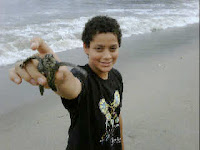
This past year has been a time of transition and growth for SEE Turtles. We started the year moving from Ocean Conservancy to work with the great group of folks at The Ocean Foundation.
In 2009, SEE Turtles:
- Launched a new website
- Unveiled a volunteer matching program that has received more than 800 inquiries
- Created a School Outreach Program that offers field trips, presentations, and more
- Added a capacity building capacity building component where we help communities in Baja, Mexico launch new conservation tourism businesses
- Built our social media reach with a new Facebook fan page (770 fans), Twitter account (almost 700 followers), and an enewsletter list with 800 subscribers
- Added new sections to our website on turtle species and threats
Despite the down economy, which dramatically reduced tourism, we helped connect 60 travelers to our partners in Costa Rica, Baja, and Trinidad. These travelers generated more than $13,000 for local communities and almost $10,000 for conservation efforts. Our grand total to date is now $62,500 generated, split between $35,500 for conservation and $27,000 for communities! In 2009, 22 volunteers completed more than 200 shifts, doing the dirty work necessary for these projects to succeed.
While we are proud of these results, we know a lot more needs to be done to protect sea turtles in these sites. SEE Turtles is gearing up for a big 2010, where we expect to more than double the number of people going to sites and the amount of money generated. Our plans for 2010 include new turtle sites, new species (starting with other ocean creatures), and more.
SEE Turtles succeeds with help from people like you. To make a tax-deductible online donation, please click here and be sure to check the box titled "SEEtheWILD" (our parent project).
Happy New Year and thanks for your support! SEE you in 2010.


